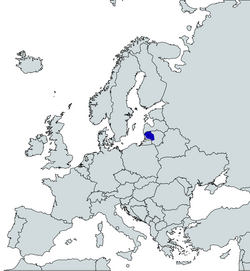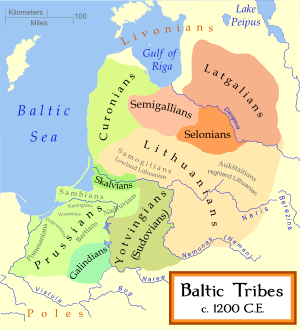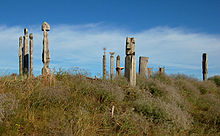Samogitia
This article needs additional citations for verification. (June 2010) |
Samogitia
Žemaitija Žemaitėjė | |
|---|---|
 Samogitian landscape near Tverai. | |
| Motto: Patria una | |
 Location of Samogitia in Europe. | |
| Coordinates: 56°00′0″N 22°15′0″E / 56.00000°N 22.25000°E | |
| Country | Lithuania |
| Capital | Telšiai |
| Largest city | Šiauliai |
| Area | |
• Total | 21,000 km2 (8,000 sq mi) |
| Population | |
| • Ethnicity | Samogitians Lithuanians |
| • Languages | Lithuanian language Samogitian dialect |
| Demonyms |
|
| Website | Unofficial website |
Samogitia or Žemaitija (Samogitian: Žemaitėjė; Template:Lang-lt; see below for alternate and historical names) is one of the five ethnographic regions of Lithuania. Žemaitija is located in northwestern Lithuania. Its largest city is Šiauliai. Žemaitija has a long and distinct cultural history, reflected in the existence of the Samogitian dialect.
Etymology and alternate names
Ruthenian sources mentioned the region as жемотьская земля, samotska sem(b)la; this gave rise to its Polish form, Żmudź, and probably to the Middle High German Sameiten, Samaythen. In Latin texts, the name is usually written as Samogitia, Samogetia etc.[1] The area has long been known to its residents and to other Lithuanians exclusively as Žemaitija (the name Samogitia is no longer in use within Lithuania and has not been used for at least two centuries). The region is also known in English as Lower Lithuania or, in reference to its Yiddish names, Zamet or Zhamot.[1][2][3][4]
Geography
Žemaitija is located in northwestern Lithuania in the territories of:
- Akmenė District Municipality
- Jurbarkas District Municipality
- Kelmė District Municipality
- Kretinga District Municipality
- Mažeikiai District Municipality
- Palanga city municipality
- Plungė District Municipality
- Raseiniai District Municipality
- Rietavas Municipality
- Šilalė District Municipality
- Skuodas District Municipality
- Tauragė District Municipality
- Telšiai District Municipality
- Šiauliai District Municipality
Eastern parts of:
Western part of:
The largest city is Šiauliai, or Klaipėda if the latter is considered in the region. Telšiai is the capital, although Medininkai (now Varniai) was once the capital of the Duchy of Samogitia.

The largest cities are (Samogitian name, if different, is provided after slash):
- Šiauliai/Šiaulē (127,059 inhabitants)
- Mažeikiai/Mažeikē (40,572 inhabitants)
- Telšiai/Telšē (30,011 inhabitants) - considered capital
- Tauragė/Tauragie (27,862 inhabitants)
- Plungė/Plongi (23,187 inhabitants)
- Kretinga (21,452 inhabitants)
- Skuodas/Skouds (7,358 inhabitants)
Demographics and language

The people of Žemaitija speak Samogitian, a dialect of the Lithuanian language that was previously considered one of 3 main dialects (modern linguists have determined that it is one of two dialects, the other being Aukštaitian, and that both of these dialects have 3 subdialects each). Samogitian has northern and southern subdialects (which are further subdivided). A western subdialect once existed in the Klaipėda region, but it became extinct after World War II after its inhabitants fled the region as a result of being expelled or persecuted by the Soviet authorities. During the 15th and 16th centuries, the Samogitians of the Klaipėda region called themselves "Lietuvininkai",[citation needed] whereas at end of 19th century when the area, known in German as the Memelland, was part of Prussia (Germany), they were known as "Prūsai." After World War II, the territory of the western subdialect was resettled mainly by northern and southern Žemaičiai and by other Lithuanians. Samogitian has a broken intonation ("laužtinė priegaidė", a variant of a start-firm accent) similar to that of the Latvian language.[5] In 2010, the Samogitian dialect was assigned with an ISO 639-3 standard language code ("sgs"), as some languages, that were considered by ISO 639-2 to be dialects of one language, are now in ISO 639-3 in certain contexts considered to be individual languages themselves.[6]
Žemaitija is one of the most ethnically homogeneous regions of the country, with an ethnic Lithuanian population exceeding 99.5% in some districts. During the first part of 19th century, Žemaitija was a major center of Lithuanian culture (Žemaičiai traditionally tended to oppose any anti-Lithuanian restrictions). The local religion is predominantly Roman Catholic, although there are significant Lutheran minorities in the south.
The use of the Samogitian dialect is decreasing as more people tend to use standard Lithuanian, although there have been some minor attempts by local councils, especially in Telšiai, to write certain roadside information in Samogitian as well some schools teach children Samogitian dialect in schools.
History


The modern concept of "dialectological" Žemaitija appeared only by the end of 19th century. The territory of ancient Samogitia was much larger than current ethnographic or "dialectological" Žemaitija and embraced all of central and western Lithuania.
The very term "Samogitians" is a Latinized form of the ancient Lithuanian name for the region's lowlanders, who dwelt in Central Lithuania's lowlands. The original subethnic Samogitia, i.e. the Central Lithuania's flat burial grounds culture, was formed as early as the 5th-6th centuries. Before that, it was inhabited by southern Semigallians and southern Curonians. The western part of historical Žemaitija became ethnically Lithuanian between the 13th and 16th centuries. The primal eastern boundary of historical Samogitia was the Šventoji River (a tributary of the Neris River) since the end of the 13th century (at about that time, the Lithuanian ruler Vytenis had expanded the territory of his domain in Aukštaitija along the Nevėžis River at the expense of Žemaitija).
Because during the 13th through 16th centuries the Teutonic Order and the Livonian Order bordered Žemaitija, it was always threatened by their expansionist aims. As such, Samogitian territory was offered to these orders, or exchanged in peace treaties, a number of times. Lithuania would then regain Žemaitija during subsequent conflicts.
For more than two hundred years, old Samogitia played a central role in Lithuania’s wars against the crusading order of the Teutonic Knights (Knights of the Cross and Knights of the Sword). Invasions started in Lithuania in 1229. Combined military forces undertook numerous campaigns against Samogitians and Lithuanians. Saule (1236), Skuodas (1239), Durbe (1260), Lievarde (1261) are just a few of the battles that took place. Since Žemaitija was the last pagan region in Europe left to be invaded and christened, the Teutonic Order set their sights on this last mission. Between 1345 and 1382, the Knights of the Cross attacked from Prussia some 70 times, while the Livonian Knights of the Sword made 30 military forays. Year after year, fortresses were attacked, farms and crops were put to the torch, women and children enslaved and men killed. Despite all their effort, the Žemaičiai managed to defend their lands until the 1410 decisive Battle of Grunwald or Žalgiris, where united Polish-Lithuanian forces defeated the Teutonic Order and ended their crusading era.[7]
In the 15th century, Žemaitija was the last region in Europe to be converted to Christianity. During the 15-18th centuries, it was known as the Duchy or Eldership of Žemaitija, which included some territories of what is now considered Aukštaitija and Suvalkija as well. The Duchy of Žemaitija was an autonomous administrative unit in the Grand Duchy of Lithuania with some similarities to a voivodeship.
After the partitions of the Polish-Lithuanian Commonwealth, Žemaitija was incorporated into the Russian Empire along with the rest of Lithuania. Žemaitija was the main source of the Lithuanian cultural revival during the 19th century and was a focal point for the smuggling of books printed in the Lithuanian language, which was banned by the occupying Russians.
After World War I, Žemaitija became a part of the newly re-established Lithuanian State. The Žemaičiai resisted the Bolsheviks, the Bermontians. As the idea of former Polish-Lithuanian Commonwealth fallen apart, Poles occupied in 1919–1920 and until 1939 the southern part of the current Lithuania, including the current Lithuanian capital Vilnius. However, Žemaitija, along with the rest of Lithuania, was occupied by the Soviet Union in 1940 as a result of the secret Molotov-Ribbentrop Pact, which the Nazis soon broke. Most of the Polish-occupied territory, including Vilnius, was returned to the Lithuanians when the Russians returned, but Lithuania itself was overrun by the Soviet Union. During World War II, Lithuania was occupied in turn by both Nazi Germany and Soviet Russians as the Eastern Front shifted. At the end of the war, all of Lithuania was surrendered to the Soviet Union, along with the other Baltic States of Latvia and Estonia, as a consequence of the Yalta Agreement. Although the United States maintained after Yalta that the Baltic states had been illegally annexed to the Soviet Union, this meant little until the administration of Mikhail Gorbachev conceded that the departure of the Baltic states was inevitable, and the Soviet Union at last recognized their independence on 6 September 1991. The last Soviet troops withdrew in August 1994.
In 1945, the Soviets denied the existence of the Lithuania Minor ethnographic region, out of political advantage, and declared the Klaipėda region a part of Žemaitija.
Tourism

Žemaitija has a huge potential for tourism development, due to its natural beauty, cultural and historical heritage. The area is attractive to many local and international tourists. The most popular tourist destinations are Palanga, Kretinga and Žemaičių Kalvarija. The majority of tourists come from Latvia, Poland, Belarus, Russia, Germany, Spain, Finland and Sweden.
Palanga is popular tourist destination among tourists from the United Kingdom, Germany and Russia.
Žemaičių Kalvarija (or New Jerusalem as it used to be called) is very popular among pilgrims from all around the world, due to its annual The Great Žemaičių Kalvarija Church Festival (usually in June or July).
Politics
Žemaitija historically was an autonomous region in the Grand Duchy of Lithuania, although it lost this status once Lithuania was annexed by the Russian Empire following the Third Partition of the Polish-Lithuanian Commonwealth in 1795 as a part of the Vilnius Governorate. In 1843, Žemaitija was incorporated into the Kaunas Governorate, with a minor part attached to the Courland Governorate. Since then, Žemaitija has not had separate political status, but there were attempts to create a separate state during the uprising in February 1831.
Currently, Žemaitija is represented by the Samogitian cultural society, a group interested in preserving Samogitian culture and language.
Symbols


The coat of arms depicts a black bear with silver claws and collar on a red shield topped with a crown. The greater arms is supported by a knight with a sword and a woman with an anchor, and has the motto Patria Una (Latin: One Fatherland).
The flag of Žemaitija depicts the coat of arms on a white background. It is a non-rectangular flag ending in two triangles, rather than the rectangular flag typically used. The only official non-rectangular flags are those of Nepal and of Ohio, USA.
Both symbols are assumed to have been in use for centuries, especially the coat of arms (differing claims assert it was first used in the 14th or 16th centuries). The symbols were used by the Eldership of Žemaitija. These are the oldest symbols of the Lithuanian ethnographic regions.
Because Žemaitija does not correspond to any current administrative division of Lithuania, these symbols are not officially used. However, they might come back into use if Lithuania undergoes administrative reform in the future.
On 21 July 1994, these symbols were recognized by the government of the Lithuanian Republic.
See also
Notes and references
- ^ a b Östen Dahl, Maria Koptjevskaja-Tamm (2001). The Circum-Baltic Languages: Typology and Contact. John Benjamins Publishing Company. p. 42. ISBN 978-90-272-3057-7.
- ^ Kevin O'Connor (2006). Culture and customs of the Baltic states. Greenwood Publishing Group. p. 231. ISBN 978-0-313-33125-1. Retrieved 5 March 2011.
- ^ Dagmar C. G. Lorenz; Gabriele Weinberger (1994). Insiders and outsiders: Jewish and Gentile culture in Germany and Austria. Wayne State University Press. p. 91. ISBN 978-0-8143-2497-4. Retrieved 5 March 2011.
- ^ Nancy Schoenburg; Stuart Schoenburg (1996). Lithuanian Jewish Communities. Rowman & Littlefield. p. 502. ISBN 978-1-56821-993-6.
- ^ http://www.lituanus.org/1982_1/82_1_02.htm
- ^ [1]
- ^ [2] "Samogitia (history)", Simas Suziedielis


